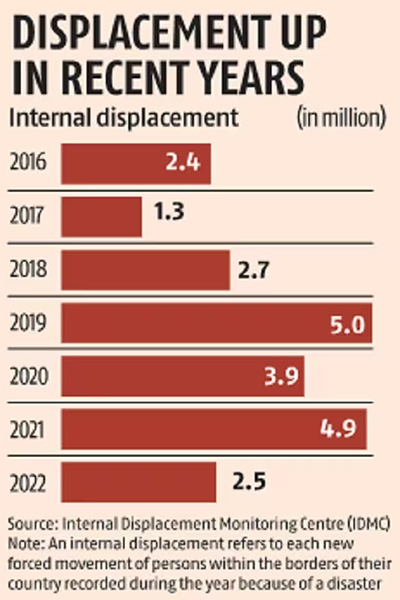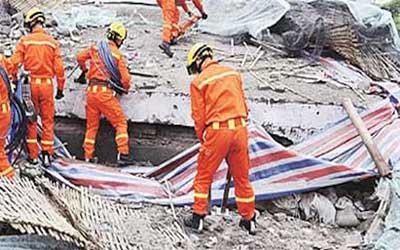Date: 18/05/2023
Relevance: GS-2: Disaster and disaster management.
Key Phrases: Internal Displacement Monitoring Centre (IDMC), internal displacement, natural disasters, humanitarian crisis, social disruption and disintegration, economic loss and poverty, long-term displacement
Context:
- An analysis of data from the Geneva-based Internal Displacement Monitoring Centre (IDMC) shows that Internal displacement in India was 2.5 million in 2022.
- The average displacement in the country in the last seven years has been over 3 million annually.
- This means that as many people as currently reside in Bhopal are displaced by natural disasters every year in India.
- The number of such displaced people in India has ranged between 1.3 5 million in the last seven years.
- There have been similar displacements due to natural disasters in neighbouring countries including Afghanistan, Pakistan (which saw floods last year), and others in the South Asia region.

What is internal displacement?
- An internal displacement refers to each new forced movement of persons within the borders of their country recorded during the year because of a disaster.
- Natural disasters can include floods, epidemics and weather-related phenomena, which affect people´s ability to continue in their place of residence.

India and Internal displacement overview: 2022
- India records some of the highest numbers of internal displacements in the world every year, the vast majority of them triggered by disasters. The scale of displacement is a result of the country’s exposure to intense and frequent hazards, its large population and socioeconomic vulnerability. In 2022, the number of disaster displacements reduced by nearly half compared to the previous year, totalling 2.5 million. Floods triggered 96 per cent of them. Rainfall and flooding were normal or below average, with some parts of the country reporting their lowest July rainfall in 122 years, which explains the decreasing trend.
- The most affected state was Assam, where the same areas were hit by floods in May and again in June. People fled in makeshift boats as their homes were destroyed, many of them to camps where water and sanitation conditions were poor. In Nagaon district, the Kopili river rose to a record height of more than a metre above danger level. An estimated 742,000 flood displacements were recorded during the pre-monsoon season between mid-May and mid-July.
- The cyclone season was less severe in 2022, and fewer displacements were recorded as a result, totalling 95,000, a significant reduction from the 2.5 million recorded in 2021. From these, around 66,000 were triggered by Cyclone Sitrang which hit the states of Odisha and West Bengal in October. Other events were cyclone Asani, which triggered more than 1,500 movements in Andhra Pradesh between 5 and 12 May, and cyclone Mandous, with over 9,500 in Tamil Nadu, Andhra Pradesh and Puducherry in December.
- In terms of conflict and violence, there is no systematic data collection on displacement in India. Figures totalled just over 1,000 in 2022, the result of localised events of intercommunal violence. As of the end of 2022, around 631,000 people were living in displacement. Many of them were displaced decades ago by conflicts in the states of Assam, Mizoram and Tripura in the north-east and Jammu and Kashmir have made, to the best of IDMC’s knowledge, little progress toward achieving durable solutions.
Source: Internal Displacement Monitoring Centre
Some of the primary causes of Internal displacement due to natural disasters
- Flooding: Floods are among the most common natural disasters that cause internal displacement. Heavy rainfall, hurricanes, or tsunamis can lead to river overflows or coastal inundation, forcing people to flee their homes and seek safety on higher ground.
- Storms and Hurricanes: Intense storms and hurricanes can result in strong winds, heavy rainfall, and storm surges, leading to widespread destruction. The destruction of infrastructure, such as houses and roads, can make areas uninhabitable and force people to move to safer locations.
- Earthquakes: Earthquakes can cause significant displacement, especially when they result in the collapse of buildings and infrastructure. People may be displaced due to the destruction of their homes or the risk of aftershocks and subsequent structural damage.
- Volcanic Eruptions: Volcanic eruptions can lead to the displacement of communities living near active volcanoes. The eruption itself, along with associated hazards like lava flows, ashfall, and toxic gases, can render areas uninhabitable, forcing people to evacuate.
- Landslides and Mudslides: Areas prone to landslides and mudslides can experience significant displacement during and after heavy rainfall or earthquakes. The destabilization of slopes can cause mass movements of earth and rocks, destroying homes and infrastructure and forcing people to relocate.
- Drought and Desertification: Prolonged periods of drought can lead to the displacement of people, particularly in arid and semi-arid regions. Lack of water and crop failures can result in food and economic insecurity, prompting people to move in search of better livelihood opportunities.
- Wildfires: Uncontrolled wildfires can cause displacement, primarily when they threaten residential areas and pose risks to human lives. Evacuation orders may be issued to ensure people's safety and protect them from the immediate danger of the fire.
- Cyclones and Typhoons: Powerful cyclones and typhoons can cause extensive damage to coastal areas, including storm surges, high winds, and heavy rainfall. Such events can lead to the destruction of homes, infrastructure, and livelihoods, necessitating the displacement of affected populations.
Effects of internal displacements due to natural disasters:
- Humanitarian Crisis: A large number of people are suddenly uprooted from their homes and left without access to basic necessities such as food, water, shelter, and healthcare. This can strain local resources and require rapid response and assistance from humanitarian organizations.
- Loss of Lives and Injuries: Natural disasters can result in the loss of lives and injuries, both directly during the event and indirectly due to the ensuing displacement. People may be injured or killed by collapsing buildings, landslides, floods, or other hazardous conditions. Displaced populations are particularly vulnerable to injuries, illnesses, and diseases due to overcrowded and unsanitary conditions in temporary shelters or refugee camps.
- Social Disruption and Disintegration: Internal displacement can disrupt social networks and community cohesion. Families and communities are often separated during the displacement process, leading to emotional distress and a loss of support systems. Displacement can also result in the breakdown of social institutions, including schools, healthcare facilities, and local governance structures.
- Economic Loss and Poverty: Displaced individuals and communities often experience significant economic losses. Destruction of homes, infrastructure, and livelihoods can lead to the loss of assets and income sources. Displaced individuals may struggle to find employment or regain their pre-displacement economic status, pushing them into poverty and long-term vulnerability.
- Increased Vulnerability: Displaced populations, especially women, children, the elderly, and people with disabilities, are often more vulnerable to exploitation, violence, and abuse. Inadequate living conditions, overcrowding, and lack of security can make them susceptible to physical, sexual, and emotional harm. Displacement can also exacerbate pre-existing inequalities and discrimination within societies.
- Health Risks: Displacement can create health risks and challenges. Overcrowded living conditions in temporary shelters or refugee camps can increase the spread of infectious diseases. Displaced populations may also face difficulties accessing healthcare services, leading to an increased risk of illness and reduced overall well-being.
- Long-Term Displacement and Dependency: In some cases, internal displacement can become protracted, with individuals and communities unable to return to their original homes for an extended period. This can lead to a prolonged state of dependency on humanitarian assistance and a loss of self-sufficiency and resilience.
Way Forward:
- Addressing the effects of internal displacement requires comprehensive and coordinated efforts, including providing immediate humanitarian aid, ensuring access to basic services, supporting livelihood recovery, promoting social integration, and implementing durable solutions for long-term displacement.
Source: Business-Standard
Mains Question:
Q. Discuss the causes and effects of internal displacements due to natural disasters.( 200 words).







